Managing Emotions in the Workplace
Added on 2022-11-29
32 Pages7797 Words493 Views
Manage People Effectively
Question 1
Briefly explain what is meant by ‘emotional intelligence’.
Emotional intelligence is defined as ability for monitoring one’s own as well as
emotions of people in order to discriminate among various emotions as well as
label them properly. It is used of emotional information for guiding thinking as
well as behaviour. The emotional intelligence is consisted self-regulations, self-
awareness, motivation as well as social skills. For example, they take
responsibilities for their actions that are quite positive.
Question 2
Describe two benefits of encouraging the development of emotional intelligence
at an organisational level.
The two benefits of emotional intelligence at the organizational level are as
follows:
Motivation: It is found that with the help of the emotional intelligence within the
business, it is quite important to control the emotional state in order to reach to
a proper agreement.
Change: It is quite necessary for each of the individual for becoming
professional within the business for making changes and for proper innovation.
Communication: People who generally have very much high emotional
intelligence can be able to properly express themselves quite clearly. For
example, I have communicated with one of my colleagues who have better
emotional intelligence has provided all its information.
Question 3
Reflecting on your role as a leader, give two examples of times when you have
managed emotions in the workplace in an effective manner (or describe two
hypothetical or best-case examples which would be suitable for your workplace).
1. Anger is an emotion which I can face in the workplace when I faced trouble to
manage temper at the work. I faced this trouble when I am not able to make the
colleagues convince of my decisions. When I faced this emotion, I closed my
eyes as well as practice deep breathing exercises before react on the situation.
2. I sometimes worked with someone I did not get along with, and it is the time
to aside the pride as well as ego. I can manage it by treating person with respect
and when the person in front of me behaved in unprofessional way, then I was
not meant to behave with them in similar way.
Question 4
Question 1
Briefly explain what is meant by ‘emotional intelligence’.
Emotional intelligence is defined as ability for monitoring one’s own as well as
emotions of people in order to discriminate among various emotions as well as
label them properly. It is used of emotional information for guiding thinking as
well as behaviour. The emotional intelligence is consisted self-regulations, self-
awareness, motivation as well as social skills. For example, they take
responsibilities for their actions that are quite positive.
Question 2
Describe two benefits of encouraging the development of emotional intelligence
at an organisational level.
The two benefits of emotional intelligence at the organizational level are as
follows:
Motivation: It is found that with the help of the emotional intelligence within the
business, it is quite important to control the emotional state in order to reach to
a proper agreement.
Change: It is quite necessary for each of the individual for becoming
professional within the business for making changes and for proper innovation.
Communication: People who generally have very much high emotional
intelligence can be able to properly express themselves quite clearly. For
example, I have communicated with one of my colleagues who have better
emotional intelligence has provided all its information.
Question 3
Reflecting on your role as a leader, give two examples of times when you have
managed emotions in the workplace in an effective manner (or describe two
hypothetical or best-case examples which would be suitable for your workplace).
1. Anger is an emotion which I can face in the workplace when I faced trouble to
manage temper at the work. I faced this trouble when I am not able to make the
colleagues convince of my decisions. When I faced this emotion, I closed my
eyes as well as practice deep breathing exercises before react on the situation.
2. I sometimes worked with someone I did not get along with, and it is the time
to aside the pride as well as ego. I can manage it by treating person with respect
and when the person in front of me behaved in unprofessional way, then I was
not meant to behave with them in similar way.
Question 4
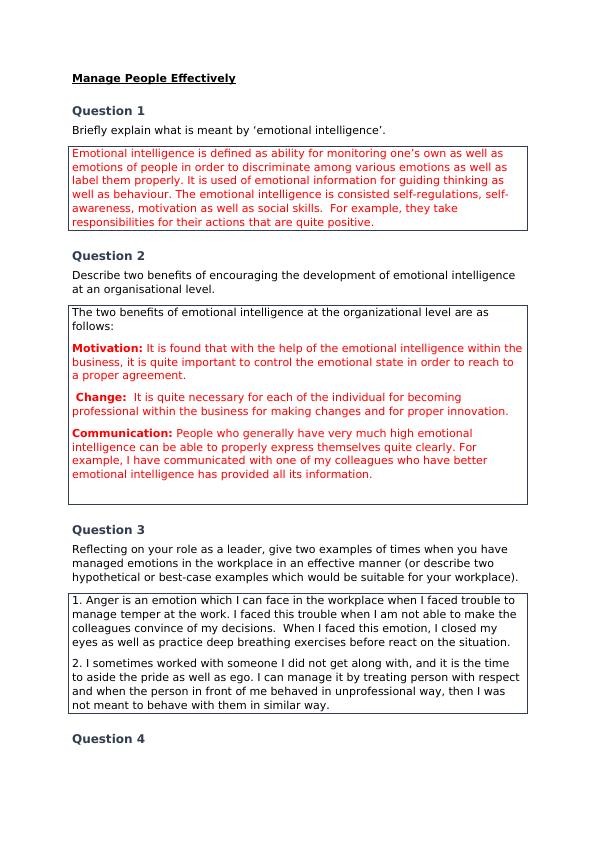
Explain the relationship between emotionally intelligent employees and the
achievement of business objectives with reference to an established Emotional
Intelligence Model or Theory (such as Goleman). (Word count: 200-500)
Goleman model is emotional intelligence model which is focused on defining the
emotional intelligence by means of skills as well as competencies which can
affect the performance of leadership. While the people are possessing
management as well as leadership potential, they are solely based on
characteristics of personalities. Emotional intelligence and business objectives is
related to each other as they can play a key role in sales as well as marketing
professionals which can receive the benefits from the training. The emotional
intelligence is helped to be stronger internal motivators which can increase in
self-confidence as well as improve ability to be focused on the organizational
goals. It can allow creating proper network for supporting as well as overcoming
with the setbacks. The emotional intelligence can help the employees to
understand strengths as well as weaknesses so that they can take feedback for
improving over the individual’s strengths. It can build relationships, reduce the
stress of team as well as improve over the satisfaction of job. They can leverage
emotions as the situations are being dictated. There is self-awareness,
motivation as well as social skills of the employees those are working into the
workplace. For example: the employees generally hear to each other views in
the meeting so that they can be able to express their views emotionally and
clearly.
Question 5
Briefly explain how using emotional intelligence can have an impact on work
health and safety and other aspects of the work environment (up to 80 words).
The emotional intelligence can help the business organization to provide a huge
impact on the work health as well as safety as it helps to understand own
strengths as well as weaknesses. The mental experts believed that emotional
intelligence is a valuable asset into the workplace as the employees with higher
level of emotions can properly cooperate with others; They can also manage
work related stress and also conflicts into the workplace relations and learn from
the interpersonal mistakes. For example, if an employee can be able to express
their thoughts, then they are unable to create negative impact on the health and
their safety.
Question 6
Identify 3 strategies you can use when communicating with culturally diverse
people who may have different ways of expressing emotion than you do (word
count: 20-80).
The lists of three strategies are as follows:
1. Maintenance of the normal volume
2. Prioritization as well as sequence of the workplace related instructions
3. Respond to the expressed emotions
achievement of business objectives with reference to an established Emotional
Intelligence Model or Theory (such as Goleman). (Word count: 200-500)
Goleman model is emotional intelligence model which is focused on defining the
emotional intelligence by means of skills as well as competencies which can
affect the performance of leadership. While the people are possessing
management as well as leadership potential, they are solely based on
characteristics of personalities. Emotional intelligence and business objectives is
related to each other as they can play a key role in sales as well as marketing
professionals which can receive the benefits from the training. The emotional
intelligence is helped to be stronger internal motivators which can increase in
self-confidence as well as improve ability to be focused on the organizational
goals. It can allow creating proper network for supporting as well as overcoming
with the setbacks. The emotional intelligence can help the employees to
understand strengths as well as weaknesses so that they can take feedback for
improving over the individual’s strengths. It can build relationships, reduce the
stress of team as well as improve over the satisfaction of job. They can leverage
emotions as the situations are being dictated. There is self-awareness,
motivation as well as social skills of the employees those are working into the
workplace. For example: the employees generally hear to each other views in
the meeting so that they can be able to express their views emotionally and
clearly.
Question 5
Briefly explain how using emotional intelligence can have an impact on work
health and safety and other aspects of the work environment (up to 80 words).
The emotional intelligence can help the business organization to provide a huge
impact on the work health as well as safety as it helps to understand own
strengths as well as weaknesses. The mental experts believed that emotional
intelligence is a valuable asset into the workplace as the employees with higher
level of emotions can properly cooperate with others; They can also manage
work related stress and also conflicts into the workplace relations and learn from
the interpersonal mistakes. For example, if an employee can be able to express
their thoughts, then they are unable to create negative impact on the health and
their safety.
Question 6
Identify 3 strategies you can use when communicating with culturally diverse
people who may have different ways of expressing emotion than you do (word
count: 20-80).
The lists of three strategies are as follows:
1. Maintenance of the normal volume
2. Prioritization as well as sequence of the workplace related instructions
3. Respond to the expressed emotions
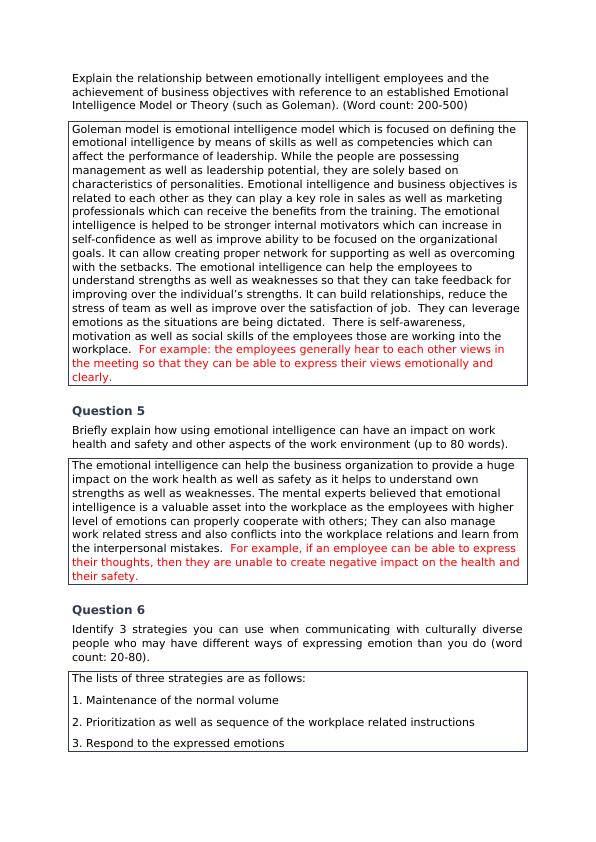
Question 7
Organisations can promote effective workplace relationships by having clearly
stated organisational policies and procedures which specify appropriate
behaviours. Provide written explanations or include examples of policies and
procedures which apply in your workplace or a previous workplace for the
following list (if policies and procedures don’t exist then provide a recommended
example or description instead);
a. Communication protocols – internal, external and cross-cultural
communication policies and procedures
We need to identify that people are coming from various backgrounds as
well as cultures with them and they can bring different values and beliefs.
It is quite necessary to follow internal, external as well as cross-cultural
communication-based policies and procedures. Example of communication
protocol include transfer protocol, user datagram protocol, hypertext
protocol as well as simple mail transfer protocol.
b. Cultural diversity and inclusion policies, e.g. EEO
The cultural diversity as well as inclusion-based policies are generally
elaborated below:
1) Identify and value with the nature of the society as well as university
community
2) Emphasize with value of the cultural diversity as well as commitment
with the cultural inclusiveness
3) Proper strategies should be utilized for promoting the diversity of the
workplace in order to prevent as well as respond to various types of
discrimination that generally occur.
c. Professional conduct and ethics policies, e.g. Code of Conduct
The professional conduct as well as ethics-based policies are generally
listed below:
1) Providing process for considerations of the claims for the harassment
2) Proper guidance to the employees must be provided in the situations
involved with ethics as well as professional conducts
3) Proper supporting framework for resisting the pressure and for making
proper acceptable pressure should be provided.
d. Professional Networking policy or strategy
Organisations can promote effective workplace relationships by having clearly
stated organisational policies and procedures which specify appropriate
behaviours. Provide written explanations or include examples of policies and
procedures which apply in your workplace or a previous workplace for the
following list (if policies and procedures don’t exist then provide a recommended
example or description instead);
a. Communication protocols – internal, external and cross-cultural
communication policies and procedures
We need to identify that people are coming from various backgrounds as
well as cultures with them and they can bring different values and beliefs.
It is quite necessary to follow internal, external as well as cross-cultural
communication-based policies and procedures. Example of communication
protocol include transfer protocol, user datagram protocol, hypertext
protocol as well as simple mail transfer protocol.
b. Cultural diversity and inclusion policies, e.g. EEO
The cultural diversity as well as inclusion-based policies are generally
elaborated below:
1) Identify and value with the nature of the society as well as university
community
2) Emphasize with value of the cultural diversity as well as commitment
with the cultural inclusiveness
3) Proper strategies should be utilized for promoting the diversity of the
workplace in order to prevent as well as respond to various types of
discrimination that generally occur.
c. Professional conduct and ethics policies, e.g. Code of Conduct
The professional conduct as well as ethics-based policies are generally
listed below:
1) Providing process for considerations of the claims for the harassment
2) Proper guidance to the employees must be provided in the situations
involved with ethics as well as professional conducts
3) Proper supporting framework for resisting the pressure and for making
proper acceptable pressure should be provided.
d. Professional Networking policy or strategy
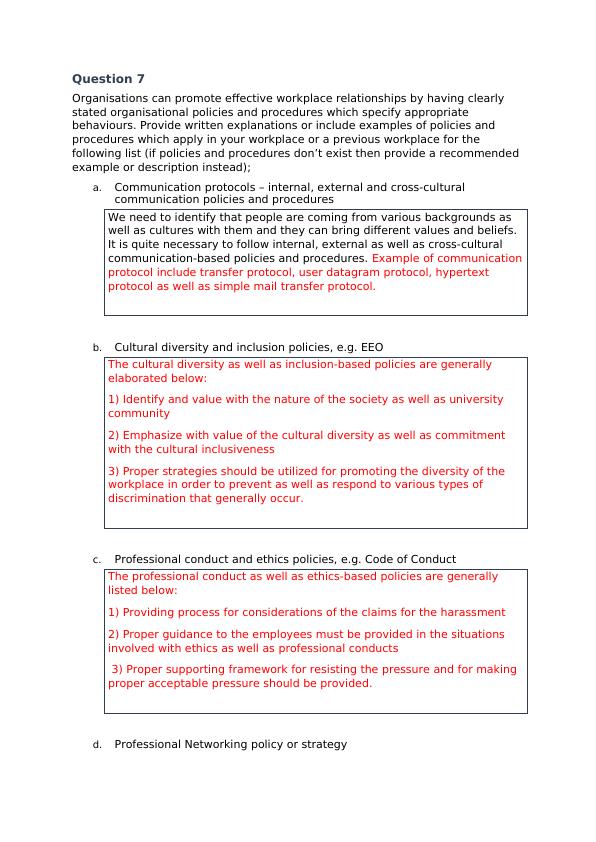
The various types of professional policy or strategies that needs to be
used are mainly listed below:
1) Proper focus should be provided on relationship building
2) Investing within time as well as on the money
3) Development of policies with respond to the practical as well as legal
implications
e. Government, media, industry and/or any other organizations with which
your organization has formed relationships; who are these bodies and
what protocols are in place for liaison with them?
The protocol and liaison services are served as protocol; require of
secretariat included secretary general and deputy secretary general.
The government, media, industry and others are the governmental bodies
or public bodies.
f. Conflict resolution policy, procedures and/or strategies
The policies, procedures as well as strategies that are generally utilized
are listed below:
1) Proper clarification about the reason of disagreement within the entire
organization
2) Proper as well as effective establishment of common goal for different
parties
3) Discussion on meeting the common goal as well as discussing on the
barriers that are associated with the goal.
4) Handling of the conflicts in the workplace included avoiding,
compromising as well as collaborating
g. Work Health and Safety policy and procedures
The work health and safety policy as well as procedures are listed below:
1) Proper duties of the employer in order to maintain health and safety
policy
2) Proper resolution of work and safety related issues and challenges
3) Monitoring the health of the employees and proper conditions within
the entire workplace.
4) Guiding and directing the employees to work with safety as well as
prevent of the injuries
h. Grievance and complaints policy and procedures
used are mainly listed below:
1) Proper focus should be provided on relationship building
2) Investing within time as well as on the money
3) Development of policies with respond to the practical as well as legal
implications
e. Government, media, industry and/or any other organizations with which
your organization has formed relationships; who are these bodies and
what protocols are in place for liaison with them?
The protocol and liaison services are served as protocol; require of
secretariat included secretary general and deputy secretary general.
The government, media, industry and others are the governmental bodies
or public bodies.
f. Conflict resolution policy, procedures and/or strategies
The policies, procedures as well as strategies that are generally utilized
are listed below:
1) Proper clarification about the reason of disagreement within the entire
organization
2) Proper as well as effective establishment of common goal for different
parties
3) Discussion on meeting the common goal as well as discussing on the
barriers that are associated with the goal.
4) Handling of the conflicts in the workplace included avoiding,
compromising as well as collaborating
g. Work Health and Safety policy and procedures
The work health and safety policy as well as procedures are listed below:
1) Proper duties of the employer in order to maintain health and safety
policy
2) Proper resolution of work and safety related issues and challenges
3) Monitoring the health of the employees and proper conditions within
the entire workplace.
4) Guiding and directing the employees to work with safety as well as
prevent of the injuries
h. Grievance and complaints policy and procedures
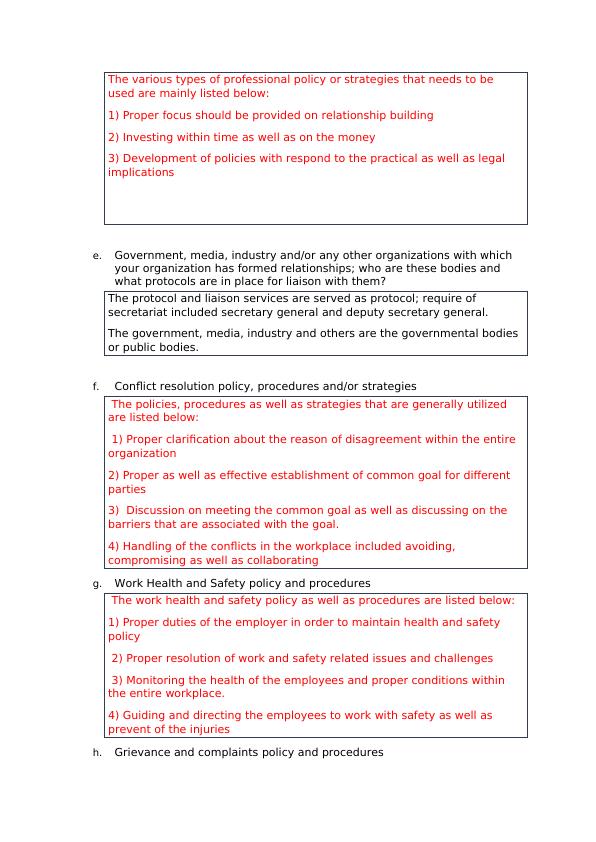
The grievance complaints-based policy as well as procedures are generally
listed below:
1). All the employees must try their best in order to resolve the problems
as well as issues in the workplace with proper formality.
2) All the different types of effort should be put for properly addressing the
matters that generally reach the stage quite successfully.
3) Providing fair processes for the individual employees for obtaining
resolution to the problems related to the employment
Question 8
Identify and briefly summarize 2 pieces of legislation which relate specifically to
workplace relations/relationships.
Equal pay act of 1963 is the legislation which can protect men as well as women
to perform equal work from the wage discrimination based on the gender.
Title VII of the civil rights act of 1964 is the legislation which can prohibit the
discrimination of employment based on race, gender, religion and others.
Question 9
Give three examples of times when you have behaved in an inclusive manner,
actively accommodating difference. Explain each situation – where was the area
of difference and what did you do to overcome potential or actual barriers?
The three different examples are generally given below:
1) Encourage of active listening is a problem before presenting the own
viewpoint
2) Difference in the vocabulary
3) Failure of the university staffs as well as students in order to behave with
dignity
Question 10
How is information shared at your organisation, how are key messages passed
on to a) staff and b) external parties? Describe three ways information is shared
listed below:
1). All the employees must try their best in order to resolve the problems
as well as issues in the workplace with proper formality.
2) All the different types of effort should be put for properly addressing the
matters that generally reach the stage quite successfully.
3) Providing fair processes for the individual employees for obtaining
resolution to the problems related to the employment
Question 8
Identify and briefly summarize 2 pieces of legislation which relate specifically to
workplace relations/relationships.
Equal pay act of 1963 is the legislation which can protect men as well as women
to perform equal work from the wage discrimination based on the gender.
Title VII of the civil rights act of 1964 is the legislation which can prohibit the
discrimination of employment based on race, gender, religion and others.
Question 9
Give three examples of times when you have behaved in an inclusive manner,
actively accommodating difference. Explain each situation – where was the area
of difference and what did you do to overcome potential or actual barriers?
The three different examples are generally given below:
1) Encourage of active listening is a problem before presenting the own
viewpoint
2) Difference in the vocabulary
3) Failure of the university staffs as well as students in order to behave with
dignity
Question 10
How is information shared at your organisation, how are key messages passed
on to a) staff and b) external parties? Describe three ways information is shared

within and externally, include different types of information to illustrate different
approaches to information sharing that is used for different content and
contexts.
There is exchange of information as well as information sharing is to be done in
the business organization or workplace where the key messages are to be
shared from one to other. It is done through electronically mode and using
certain communication systems. The online information sharing is provided with
useful data to the business for the future strategy’s dependent on the online
sharing. Following are the three ways which are required in information sharing
both internally and externally such as:
1. The internal communication is performed with regular in-person meetings with
the core project communication team.
2. Schedule of conference calls which allowed in information sharing as well as
brainstorming as a project team.
3. External communication is done by establishing of email to the external
people to reach them out to ensure that they are being informed as well as on-
board with the efforts.
Question 11
Explain requirements to maintain privacy and confidentiality in the workplace
and discuss how your organisation complies with these requirements; give an
example of external (regulatory) and internal (organisational policies)
compliance methods.
In the workplace, confidentiality is required as it is key significant for building as
well as maintaining of the trust as well as making sure that there is making of
open communication among the customers and clients. The workplace
confidentiality is required into the workplace for keeping the employees as well
as client’s information private. The employees are required to understand
importance only when the company is expected to treat the information of client
at highest priority and secure them.
External (regulatory) compliance method is the workplace’s adherence to the
regulations as well as guidelines relevant to the business processes. For
example, when the employees are endangering with the health as well as safety
of the workplace by performing something which is dangerous, then it is not
accurate to compromise.
Internal (organisational policies) compliance methods are being designed for
influencing the decisions as well as actions and activities which are to be taken
place into the boundaries set by the workplace. For example, the company can
announce of policy for preventing the discrimination into the employment as
there is corporate value as well as organizational goals. It severs to provide
compliance of the workplace with law.
approaches to information sharing that is used for different content and
contexts.
There is exchange of information as well as information sharing is to be done in
the business organization or workplace where the key messages are to be
shared from one to other. It is done through electronically mode and using
certain communication systems. The online information sharing is provided with
useful data to the business for the future strategy’s dependent on the online
sharing. Following are the three ways which are required in information sharing
both internally and externally such as:
1. The internal communication is performed with regular in-person meetings with
the core project communication team.
2. Schedule of conference calls which allowed in information sharing as well as
brainstorming as a project team.
3. External communication is done by establishing of email to the external
people to reach them out to ensure that they are being informed as well as on-
board with the efforts.
Question 11
Explain requirements to maintain privacy and confidentiality in the workplace
and discuss how your organisation complies with these requirements; give an
example of external (regulatory) and internal (organisational policies)
compliance methods.
In the workplace, confidentiality is required as it is key significant for building as
well as maintaining of the trust as well as making sure that there is making of
open communication among the customers and clients. The workplace
confidentiality is required into the workplace for keeping the employees as well
as client’s information private. The employees are required to understand
importance only when the company is expected to treat the information of client
at highest priority and secure them.
External (regulatory) compliance method is the workplace’s adherence to the
regulations as well as guidelines relevant to the business processes. For
example, when the employees are endangering with the health as well as safety
of the workplace by performing something which is dangerous, then it is not
accurate to compromise.
Internal (organisational policies) compliance methods are being designed for
influencing the decisions as well as actions and activities which are to be taken
place into the boundaries set by the workplace. For example, the company can
announce of policy for preventing the discrimination into the employment as
there is corporate value as well as organizational goals. It severs to provide
compliance of the workplace with law.
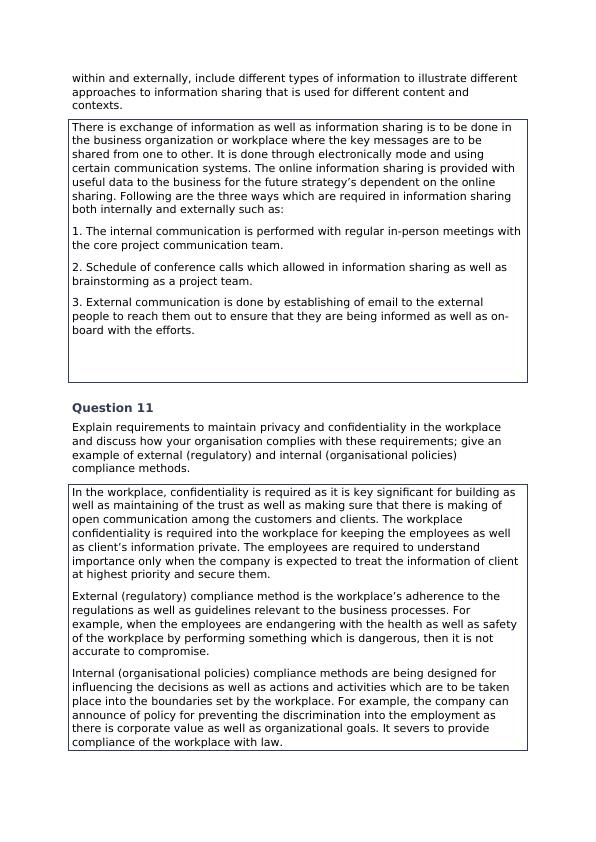
Question 12
How does your organisation foster input from team members at various levels
within the organisation? How do team members raise suggestions or give
feedback?
The organization can promote a better teamwork among the staff members by
recognizing the strengths, setting of organizational goals as well as defining with
the objectives. The managers are playing a key role to oversee with the
progress, provide with the feedback plus reward the organizational teams. They
can encourage the viewpoints into safer environment, as well as embrace with
diversity. The team members are raised suggestions and gave feedback by using
the survey method, interview of the employees and workplace review.
Question 13
What do you do as a leader to collaborate, consult with and include employees
and other stakeholders in discussions, problem-solving and action-planning?
Give at least two examples of drawing on others’ strengths and input, or
research best practice and provide hypothetical methods of doing so.
1. The leader should perform a meeting with the project team members so that
they can discuss the project related problems with them. With discussion of the
problems, action plan is prepared based on which the team members should
perform the workplace work.
2. There is conducting of consultations with the staffs as well as board with the
strategic planning. The employees are experiencing interaction with the
workplace leaders so that proper decisions are to be taken into account.
Question 14
Explain the basic principles of negotiation, mediation and conflict resolution and
provide an example of when you have (or could) followed these principles in your
role as workplace leader.
The basic principles of the negotiation are:
1. Separating of people from the problems
2. Focusing on the interests
3. Investing the options for the mutual gains
4. Insisting on the objective criteria
The basic principles of the mediation are:
How does your organisation foster input from team members at various levels
within the organisation? How do team members raise suggestions or give
feedback?
The organization can promote a better teamwork among the staff members by
recognizing the strengths, setting of organizational goals as well as defining with
the objectives. The managers are playing a key role to oversee with the
progress, provide with the feedback plus reward the organizational teams. They
can encourage the viewpoints into safer environment, as well as embrace with
diversity. The team members are raised suggestions and gave feedback by using
the survey method, interview of the employees and workplace review.
Question 13
What do you do as a leader to collaborate, consult with and include employees
and other stakeholders in discussions, problem-solving and action-planning?
Give at least two examples of drawing on others’ strengths and input, or
research best practice and provide hypothetical methods of doing so.
1. The leader should perform a meeting with the project team members so that
they can discuss the project related problems with them. With discussion of the
problems, action plan is prepared based on which the team members should
perform the workplace work.
2. There is conducting of consultations with the staffs as well as board with the
strategic planning. The employees are experiencing interaction with the
workplace leaders so that proper decisions are to be taken into account.
Question 14
Explain the basic principles of negotiation, mediation and conflict resolution and
provide an example of when you have (or could) followed these principles in your
role as workplace leader.
The basic principles of the negotiation are:
1. Separating of people from the problems
2. Focusing on the interests
3. Investing the options for the mutual gains
4. Insisting on the objective criteria
The basic principles of the mediation are:
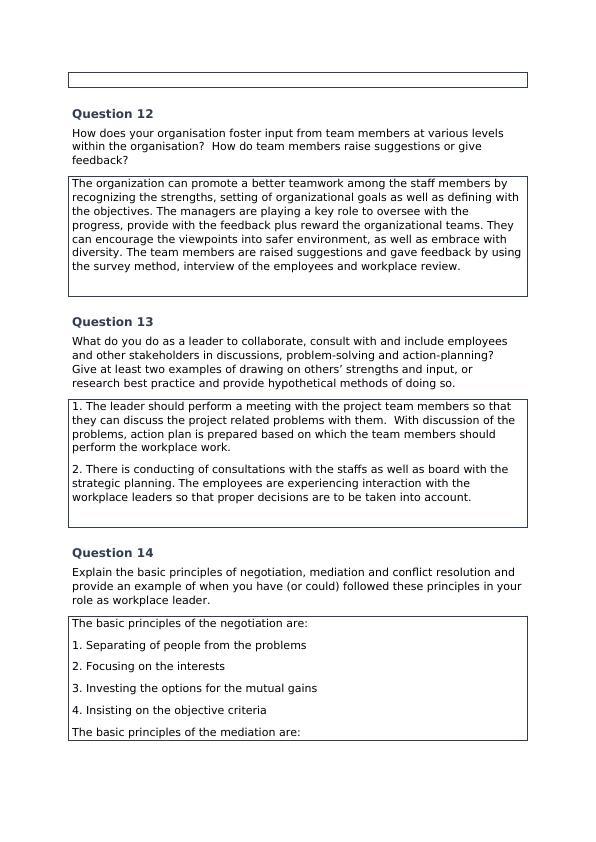
1. Confidentiality is a principle means what is said as well as written throughout
proceeding of the mediation can be used.
2. The mediator can act as impartially as well as neutrally. Impartiality of the
mediator can ensure that the parties should accept person those are dedicated
to resolve dispute.
3. The mediator procedure is started if there is agreement among the parties.
The basic principles of the conflict resolution are:
1. Dealing with the conflicts at lower level of intensity possibility
2. Suggestions of options to provide people with paths to get out of the
workplace conflicts
Question 15
Conflict is not always bad; it can bring about positive outcomes and change.
From your workplace identify a conflict that has occurred and been resolved
successfully.
a. Explain the nature of the conflict.
b. What were the processes and strategies used to achieve an outcome?
c. What negotiation strategies were used in resolving the conflict?
a. The nature of conflict is that there is moment of truth into relationship, crisis
which can weaken and strengthen it, critical events which can bring as lasting
resentment. The conflicts are occurred among groups in workplace and between
the societies.
b. The processes and strategies used to achieve an outcome in the workplace
are creating of daily schedule as well as follow it to meet with the organisational
goals. There is setting of milestones which are to be followed to meet with the
project completion date.
c. The negotiation strategies which were used to resolve the conflict are
considering the interests as well as business values, engagement with
relationships with the client and appealing to overarch with the business values.
Question 16
Identify the networks (of both individuals and groups) that you utilise when
building workplace relationships.
The network is included with group of people those can collaborate with others.
They are implied with people those are working closely as well as with
connections in the workplace purpose. Following are the list of networks such as:
1. Work team
2. Union meeting with the workplace
3. Staff members
proceeding of the mediation can be used.
2. The mediator can act as impartially as well as neutrally. Impartiality of the
mediator can ensure that the parties should accept person those are dedicated
to resolve dispute.
3. The mediator procedure is started if there is agreement among the parties.
The basic principles of the conflict resolution are:
1. Dealing with the conflicts at lower level of intensity possibility
2. Suggestions of options to provide people with paths to get out of the
workplace conflicts
Question 15
Conflict is not always bad; it can bring about positive outcomes and change.
From your workplace identify a conflict that has occurred and been resolved
successfully.
a. Explain the nature of the conflict.
b. What were the processes and strategies used to achieve an outcome?
c. What negotiation strategies were used in resolving the conflict?
a. The nature of conflict is that there is moment of truth into relationship, crisis
which can weaken and strengthen it, critical events which can bring as lasting
resentment. The conflicts are occurred among groups in workplace and between
the societies.
b. The processes and strategies used to achieve an outcome in the workplace
are creating of daily schedule as well as follow it to meet with the organisational
goals. There is setting of milestones which are to be followed to meet with the
project completion date.
c. The negotiation strategies which were used to resolve the conflict are
considering the interests as well as business values, engagement with
relationships with the client and appealing to overarch with the business values.
Question 16
Identify the networks (of both individuals and groups) that you utilise when
building workplace relationships.
The network is included with group of people those can collaborate with others.
They are implied with people those are working closely as well as with
connections in the workplace purpose. Following are the list of networks such as:
1. Work team
2. Union meeting with the workplace
3. Staff members
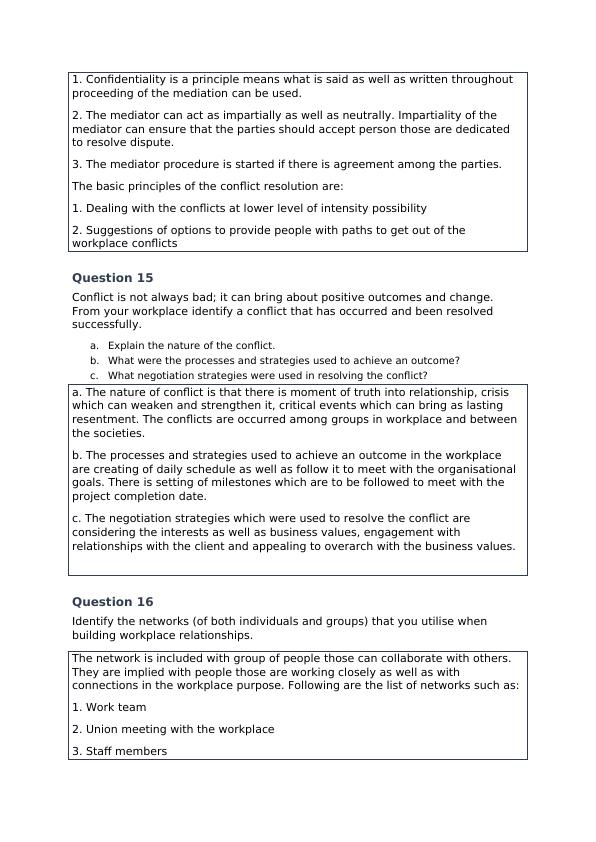
End of preview
Want to access all the pages? Upload your documents or become a member.
Related Documents
Emotional Intelligence, Cultural Intelligence and Diversity Analysis 2022lg...
|6
|1472
|15
Reflection on My Emotional Intelligencelg...
|7
|863
|455
Emotional Intelligencelg...
|12
|1868
|45
Emotional Intelligence in Organizational Behaviorlg...
|6
|871
|149
Emotional Intelligence, Cultural Intelligence & Diversity: An Analysislg...
|8
|1773
|90
Emotional Intelligence, Cultural Intelligence and Diversitylg...
|10
|2106
|232
